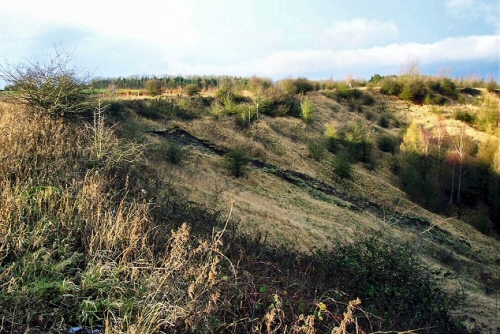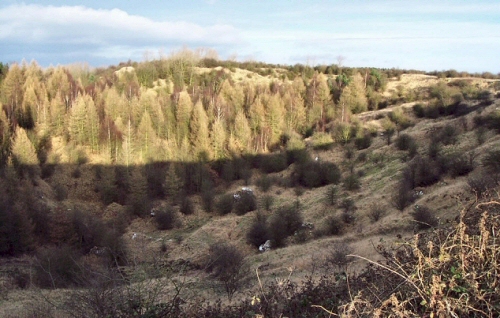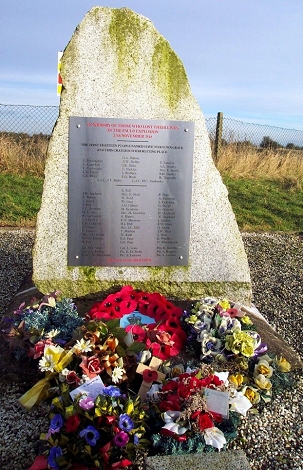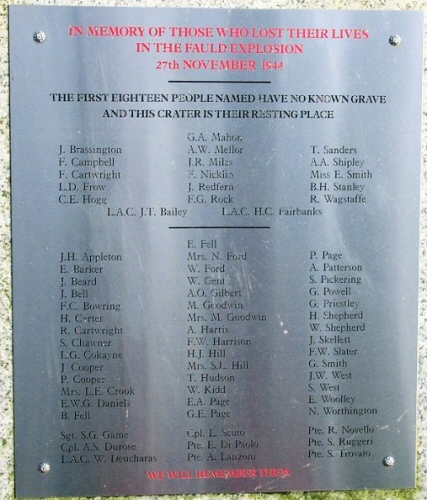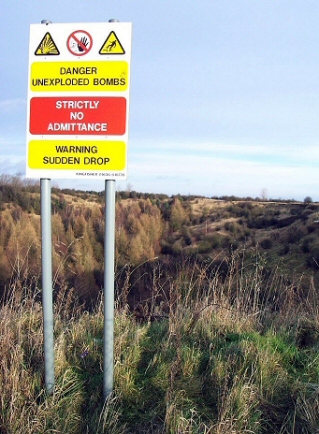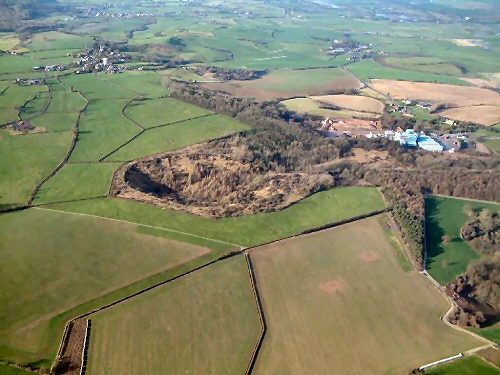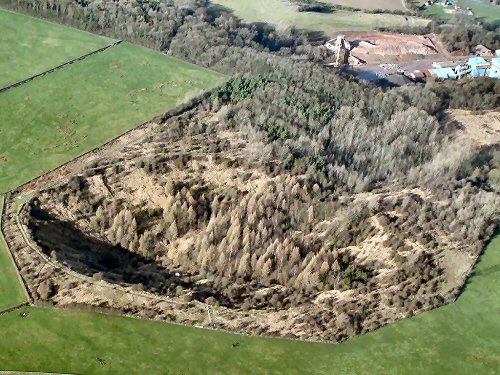The Fauld Explosion
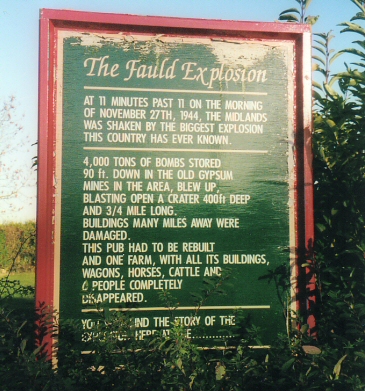
11.11 am. 27 November 1944
In 1937, 450,000 square feet of disused gypsum workings next to Peter Ford's plaster works were purchased by the Air Ministry for weapons storage during the Second World War. The RAF venture into underground storage was one of disaster and tragedy.
The depot at Fauld became the site of the largest explosion in the UK, when 3,670 tons of bombs stored underground exploded en masse. Two explosions occurred where bombs were stocked in bunkers covering 180,000 sq ft of concreted corridors. The passages were 12' high x 20' wide and had space for trucks. Inside the atmosphere was 'clear air' at 55 F.
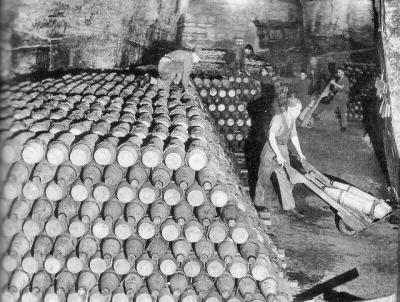
Stacks of 6" howitzer shells
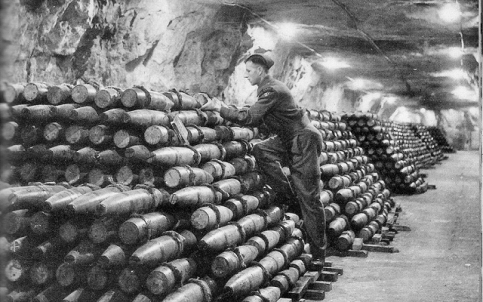
500 tons of shells awaiting despatch during the build up to the Normandy Invasion
After the explosion there was a mushroom cloud, about 50 yards wide and upwards out of sight. Mounds of earth weighing up to a ton in weight fell to the ground. Afterwards a fine dust up to 4 inches thick fell, and it was possible to walk without making any noise. A crater, half a mile across and 100 feet deep was left behind.

Firefighters from Burton, Stafford and Lichfield attended. At the depot, both R.A.F. personnel and Italian prisoners of war were employed. Both airmen and Italians were killed in the blast.
The entire mine was not destroyed, but the hills housing the mine completely disappeared. Virtually every house in Hanbury Village was severely damaged – the Cock Inn lost half of its roof and Upper Hayes Farm completely vanished. In Tutbury, chimney pots and roofs were shattered and two church steeples in Burton were cracked – one had to be taken down. The blast was heard as far south as Daventry, 19 miles south of Coventry and at Weston Super Mare. Seismographs recorded the shock waves at Casablanca.
Below are pictures of the crater that was formed by the blast:
4,000 tons of Bombs blew up, only three larger blasts were recorded during the War - those at Hiroshima, Nagasaki and the New Mexico Tests. The crater is 90ft deep and covers 12 Acres. A local reservoir containing 6 million gallons of water completely disappeared.
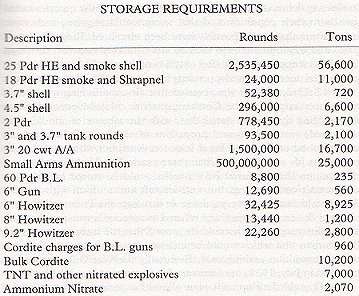
In 1974 it was officially revealed that the explosion was caused by bombs being taken out of store - primed for use and replaced unused, with the detonators still installed. The death toll was in all 78 (though numbers vary according to which paper you are reading) including local people - civilian workers at the depot and workers at the local plaster mill then known as 'Fords' Plaster Mill where the second explosion occurred.
The rescue work took three months and was hindered by pockets of gas, 6 million gallons of water from the reservoir and 10,000 tons of rubble. During the 'mopping up operations', R.A.F. personnel were sent out to ensure that people and animals needing assistance were located. One search party found a cow standing motionless, twice it's normal size obviously inflated by air under pressure. The party quickly shot the animal to save further pain, but it failed to fall down - it was obviously already dead, but the position of it's legs were maintaining it's upright position.
Also in the rounding up and checking procedure, one party entered a Farmhouse at 3.p.m. (4 hours after the blast) and found an elderly couple sitting at the table with the remains of their meal, sitting in a state of shock just looking at each other, with roof debris mingling in with the food. After re-assurance that there would be no further explosions they were led to safety with relatives locally.
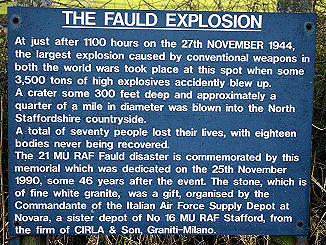
Roughly the fatalities were divided as follows: 25 killed or missing at the main depot, 41 dead at the 'Ford's Plaster Mill' and a further dozen or so local people - farmworkers etc. Among the listed dead are many local names still familiar in the villages of Hanbury, Tutbury, Hatton and area.
Fauld only ceased holding high explosives in 1958.
Recently, a memorial has been erected and trees planted:
For the last few years the crater has been sealed off and warning notices erected.
When my children were young, they used to play there, they called it the 'bomb-hole' and loved rolling stones down the hill. No one knew there was any danger at the time !!
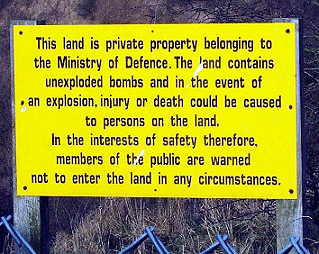
Fauld Explosion Memorial Window, Hanbury Church
When a memorial was planned it was decided to use what is perhaps the church's greatest treasure, some 14th century stained glass which for years had been in a vestry window. In the centre is depicted the Holy Trinity. We can see the lower part of a figure of the Almighty wearing a purple robe with an ornamental border. The left hand supports a cross on which hangs our Lord. From his pierced hand drops of blood are falling onto the robe. At the foot is an orb and at the top of the panel are the letters 'IHC'. In the left hand window is the figure of John the Baptist and above a fragment of a monogram.
Fauld Explosion - Relief Fund
At the time, the nation had been at war for five years and losses of life had become commonplace. The Arnhem defeat had only been a few weeks previous and the Ardennes counter offensive was being launched by the Allies. This disaster came to be regarded as a local one after a few days national publicity. The local people decided that a fund be raised to mitigate any financial hardship. A service in the church on 3rd December 1944 raised £85. By the end of December 1944 the Fund stood at £1220.
Offers to adopt any orphaned children were received from a lady in Stoke-onTrent, a gentleman in Sheffield and an Orphans Home at Brighouse. Fortunately no children were orphaned by this disaster. After two weeks the Government departments sprang into action and stated that they would pay, for a period of ten weeks only, the following sums to families affected by this disaster only.
* For families the sum was £2.10s.0d. per week
* For widows 32s.6d (£1.62) per week and 11s.0d (55p) per week for
each child.
* In January 1945 the first grants, of £4 to £8 were made to
special cases.
The fund soon reached £4500 which included £635 from the Mayor of Burton's Fund. By the end of 1945 the Fund reached its maximum amount of £7831. At Christmas of that year each child to the age of 16 years bereaved by the explosion had a gift of 10s.0d. and being "Victory in Europe Year" each widow and dependant adult was given £5. During 1945 the sum of £504 was distributed.
At that time criticism was voiced that the public who had donated the funds had no knowledge of the grants made. The committee then issued a few Press releases stating the amount they had distributed. Donations had dried up by the middle of 1945 and £7000 was invested in 3% Defence Bonds. Many of the applicants were on public assistance and their income was often £1.10s.0d per week.
Grants were made for children's clothing and in some cases, assistance with school fees. This was before the days of the National Health Service and doctors' bills of £2.6s.0d and £5.2s.0d were causing real hardship, which the Committee was able to alleviate. At Christmas, grants, mainly of £5 were made to beneficiaries.In 1949 a grant of £1.10s.0d was made to each dependant child for the purchase of winter boots. The cost £48. By 1949 several widows had re-married and children's ages re-checked, for grants ceased on re-marriage and when children attained the age of 16 years.
Five or six years after the explosion it appeared that some men had been so badly affected by gas and fumes at the time of the disaster that they were unable to work normally. The Trustees investigated each case and afforded assistance. The annual grants were some £500 to £600, peaking in 1951 to £838 and then falling slowly to £237. In 1959 the Fund was closed.
The Trustees endeavoured to visit all the beneficiaries even though they became scattered all over the country. Around 1950 the work of the Trustees was not helped by the Air Ministry who were not prepared to inform the Trustees of details of any payments made to claimants suffering from the effects of the Fauld Explosion, but would verify any statements made by applicants. This seemed to indicate duplicate and bogus claims.
In the Coronation year of 1953, grants of £3 and £6 were made to the beneficiaries. In 1958, Mr Ronald W Clark, a freelance journalist compiled, for Odhams Press, a series of articles on civilian heroism and the Daily Herald published impressive articles on this disaster. The gallantry and heroism of those engaged in the rescue and recovery works following the explosion was conspicuous for the following awards were made; One OBE, one MBE, four BEM, the George Medal and two gallantry awards.
Six Italian prisoners of war, known as co-operators, were killed and in 1951 enquiries were made through the Italian Embassy as to their dependants. News came through that all the families were extremely poor and the Trustees made a gift of £10 to each of them.
In October 1958 the Fund totalled £580 and Christmas gifts of £316 were made. The balance of the Fund in May 1959 was £224 and the Trustees made a final distribution .of £5.14s.7d to each of the thirty-three remaining beneficiaries. So after fifteen years the Voluntary Committee and the Trustees wound up the Fund, their efforts over that period doing much to alleviate financial hardship.
Aerial photographs courtesy of Barry Wright


